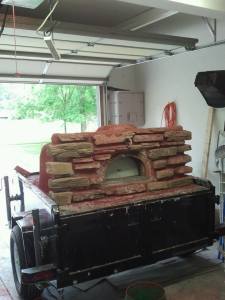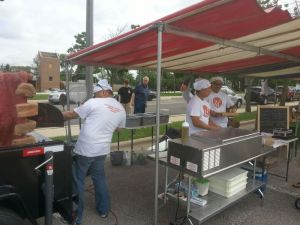We’re now three week into our markets, and inevitably, lots of changes to our work processes at the market. I’m a firm believer that in order to improve and get better at our operations at the market, it’s important to de-brief what happened each day with volunteers and co-owners so that we can analyze and correct mistakes while become leaner and more efficient as a whole. Can you tell I’ve been trained in the six sigma/lean process methodologies?
So each week that I”m at the market, I have the owners and volunteers that worked for the day come back to my house and we discuss the mistakes (e.g., pizza had to be scrapped because it stuck to peel, customer waited nearly 20 minutes for a pie, excess ingredients left over, we gave out free pie to someone that wasn’t a kickstarter backer, dealing with rain, etc.), how to avoid them in the future through process flow changes, and other ideas for improving our efficiency and reducing waste. It’s important to recognize that every suggestion, comment, or idea should be examined and explored, for two reasons:
1. Everyone’s input on the team makes a difference. You do not want to alienate someone’s thoughts, as that can create a cycle where they no longer want to submit suggestions, volunteer, etc.
2. You never know what the comment/suggestion/idea will evolve into, and could be one of the most beneficial things ever done.
I’ll dig more into the Six Sigma/Lean methodologies in different posts later on, but for now, those that will be kicking off a business, just remember: always look for room for improvement, and involve your staff that are doing the work to seek improvement suggestions. Obtaining feedback after each experience, especially if your business is part time, is an important part of the process. From our first day at market, we probably met for 2 hours discussing changes to the workflow from ordering, to dough stretching, to topping, to oven management. And it showed, as we became more efficient in week 2, and reduced our mistakes more by week 3.
For example, in week 1, we had to scrap six pies of 49 due to mistakes (12.24% error). Very high from a percentage perspective, especially for a day that we sold out of pies by 12:30 PM. But this past week, thanks to learned experience, discussing errors, and making changes to our processes, we had to scrap only three pies out of 47 that were ordered (6.38% error) , which is a nice improvement over the first week. While we didn’t sell out (we had 48 pies ready), it’s still good to see the error rate drop significantly. But as always, there’s room for more improvement…
There’s practically always another way to became more efficient from a work/cost perspective, improve output from a quantity and quality standpoint, and strategies to help make life easier for your team. And no one knows how to better improve the process, than someone who’s actually doing the work… whether it’s preparing ingredients, working the oven, sanitizing cookware, etc. the person in the job will likely best understand how to improve the workflow for themselves, which in turn can help the overall process.
But enough about process improvement for today. Onto some fun stuff!
One of the most exhilarating things that I’m sure any food establishment owner enjoys is repeat customers. Repeat customers, to me, means a lot of things:
1. The product was good (or great?). If I’m anything like the majority of the population, people will only visit a restaurant more than once if the food was tasty. To me, seeing repeat customers means that we’re making a good to great pizza that people want to come back for.
2. The experience was enjoyable. I’ve definitely been to places where the food was great, but the service was just terrible… and really, it only takes once or one important occasion. One of EyeDoc and my very first dates was at Grand Lux cafe, a place that I had frequented often as a college student, med student, and grad student. I’ve always enjoyed the breadth of menu, decent quality, and somewhat reasonable prices. But on the day I proposed to EyeDoc, we went there for brunch to celebrate and had possibly the worst customer service experience ever. That one bad experience basically drove us away, and we’ve never been back since. I know that the Soup Nazi and Sushi Nazi trend is out there, and some people love to flock to it due to just how great the food quality is, and I’d like to think that it somewhat of a minority, and somewhat due to the concept of people wanting access to what’s high demand/limited access (think long lines for limited iPhone releases on opening day). But for the vast majority, you have to create at the very least a neutral, if not enjoyable experience for them to come back.
3. The price point is reasonable. Repeat customers also lets us know that your price point is within reason for what you’re selling. In a world where you can by mass produced over processed cheese burgers from McD’s off the dollar menu, having a $7 Margherita pizza may seem like a splurge… but it’s fresh ingredients, handmade dough, handcut toppings, made to order in front of your very eyes in our hand built oven (yes, we use our hands a lot)… Yes, you’ll always have a few folks who believe that $7 for a pizza is high (especially when Domino’s, Pizza Hut, and Little Caesars offer their pizzas up often for as low as $5), but I would point back to the quality argument. We do it fresh, and I personally think we have a better product. Don’t get me wrong, I still enjoy the dollar menu at McD’s every once in awhile, but not everyone understands/tastes the difference in quality of food.. for some, food is just food. And those are folks that will be tough to win over, if you’re even trying to win them over.
Having executed on three markets, I’d have to say one of the highlights of my day is seeing our repeat customers come back for the same pizzas, or even ask us for recommendations because they trust our judgement. It’s akin to asking the sushi chef at a restaurant for omakase, simply because they trust in your tastes and abilities to prepare the food. The other highlight is to talk with those who are hesitant to try our pizza, only to come back the next week or even a few hours later to order up more because of how much they enjoyed it. Really, it’s these moments that make me realize we’re making some great pizzas.
And just for kicks, I wanted to share this picture of my nephew eating his first pizza crust ever:
He’s got two teeth (I think), just past six months old, and is chewing away at the crust! Per my sister, it took him a few minutes to figure out that the crust was food, and once he got it in his mouth, he wouldn’t stop eating! (My sis tried to take it away, only to have him cry). It’s really an honor to have his first pizza experience as a pizza we made.
So while we’re building fans of our pizza as we meet more and more people at the market, we constantly feel like we just haven’t promoted ourselves properly yet. We’ve established a Facebook page, have encouraged people to find us and follow us for more updates, but we’re not quite sure what the next step is to help get our name out there. Part of why we’re able to offer such a low cost for our pies is because we purposely made the decision to keep our price point low… which means that we have to make it up on volume.
We’ve made profit at each market from an operational standpoint (gross revenue – costs of opening each day = positive value) but we’re definitely not making much. From our initial estimates, we need to sell about 30 pizzas per day to break even. And while we continue to look for ways to reduce our costs (installing a trailer hitch to a car we own as opposed to renting a Uhaul, improving efficiency in the kitchen to reduce our rented kitchen time, etc.) ultimately we still need to increase our volume and customer exposure to have this succeed.
So in the world where social media is free and dominates the landscape, how can we go about improving our social media presence and create more exposure for our pizzas? Readers? Any thoughts/advice?
And finally, a picture of one of pizzas from market. We’ve been so busy getting pizza orders out that we haven’t had a chance to snap any photos of the pies we’ve been making! Here’s the second to last pizza we sold for the day: Bianca – Drizzle of olive oil, fresh garlic which roasts to a nice sweet flavor in the oven, and fresh mozz. Simple, elegant, and tasty. Notice the beautiful leoparding/char spotting that our oven man, Gambit (aka Charizard) was able to accomplish! While the crust is a bit thicker than I would’ve liked, I’m told the pie was delicious.




